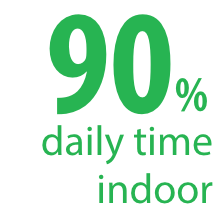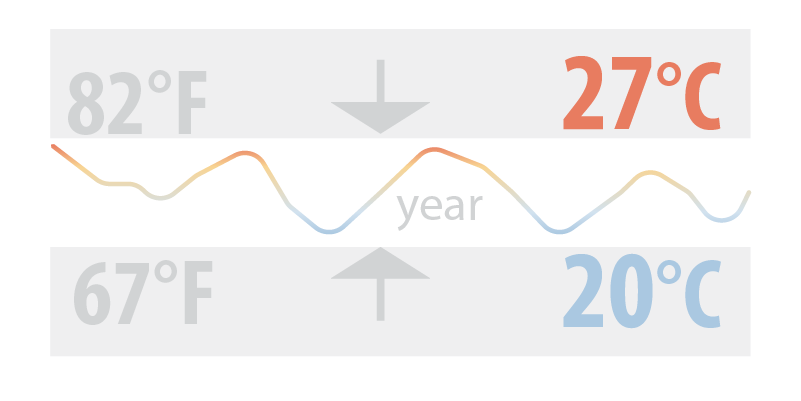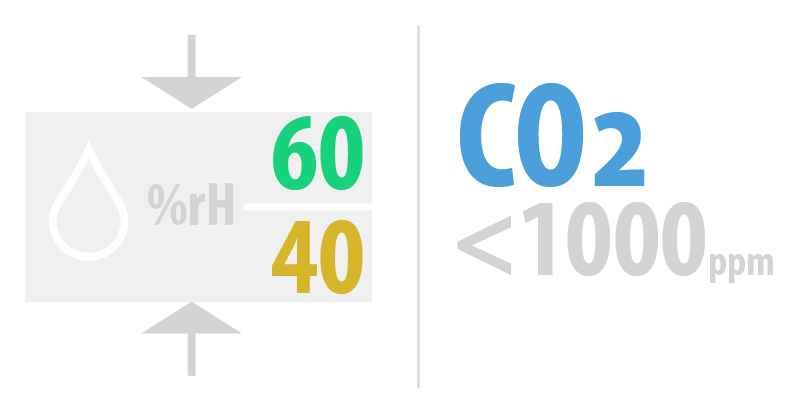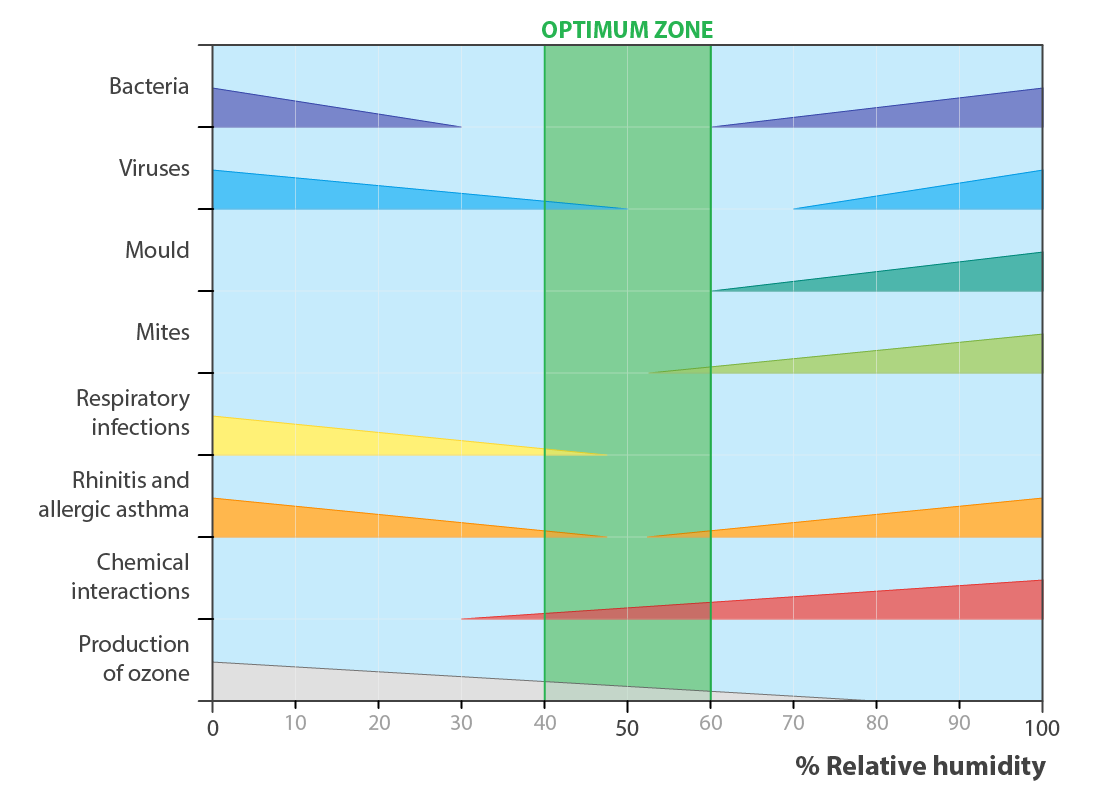Health - Indoor Air Quality - Banner

INDOOR
AIR QUALITY
Health - Indoor Air Quality - Content
Your building can make you sick or keep you well
What does indoor air quality (or IAQ in short) mean, and why is it important to talk about it?
Indoor air quality refers to the properties of air inside buildings, in relation to how these affect human health and permanence indoors.


This topic demands more attention, first of all because we spend more and more of our lives indoors.
As a study by the NHAPS (National Human Activity Pattern Survey) suggests, we spend on average of 90% of our daily time indoors[1], and indeed our health, behaviour and all-round wellbeing are dependent on indoor conditions, especially those determined by air conditioning systems.
So, how is indoor air quality measured in practice? How do we know if the air we are surrounded by is good or not? It depends from a combination of factors, so rather than just one indicator, several need to be taken into consideration.
Parameters to measure IAQ
Some of these parameters are more "famous" and their effect on us is more intuitively understood than others, however they all need to fall into a certain range in order to be acceptable. Indeed, ranges are used rather than specific values, as different people may feel different while in the same room, depending on their clothing, activity, and much more.

Temperature is a physical quantity that expresses hot and cold. It is the expression of thermal energy, present in all matter. For comfort reasons, indoor temperature is usually required to be between 67 and 82°F or 20 and 27°C throughout the year.

Relative humidity is the ratio of water vapour present in the air to the maximum amount that the same air can hold. The human body thrives at relative humidity levels between 40 and 60%.

Air speed: velocity at which air is travelling and is being supplied to a room, for example, through air conditioning ducting or open windows. Air speed should not be too high nor impact directly on the occupants of a room, in order to avoid discomfort. Recommended max indoor air speed is about 60 FPM or 0.3 m/s.

CO2 concentration: CO2 is a colourless, odourless gas produced by burning carbon and organic compounds and by respiration. It is naturally present in air (about 0.03 per cent) and is absorbed by plants through photosynthesis. It is often measured indoors as an index of human occupation, as a higher level of CO2 requires a higher air change rate. Recommended indoor CO2 level are below 1000 ppm.

VOC concentration: Volatile organic compounds (VOCs) are organic chemicals that are responsible for odours, scents and perfumes, as well as pollutants. Indoor VOC levels are usually many times higher than outdoor levels, especially due to overuse of cleaners and detergents. Long-term exposure to these chemicals may cause irritation, headaches and carcinogenic effects. Recommended levels of VOCs are below 300 ppb.

Micro-organism concentration: Indoor micro-organism concentration is responsible for the increased likelihood of bacteria and viruses spreading from person to person inside confined spaces. As they are difficult to remove or deactivate, the most effective method of dealing with this kind of indoor pollutant is to dilute them, by increasing recirculation through fresh outside air intake.

Noise level: Sound is a vibration that propagates as an wave through a transmission medium such as a gas, liquid or solid. To not cause discomfort for occupants of rooms, the sound level should be below 40-60 dB.
Just to give few numerical example:
temperature is usually required to be between 67 and 82°F or 20 and 27°C throughout the year

relative humidity between 40 and 60%, and indoor CO2 levels lower than 1000 ppm.

The problem is that when these indoor air quality values are outside of these ranges, the human body starts to suffer. Symptoms are very diverse, and may include headache, dizziness, nausea, eye, nose or throat irritation, dry cough, dry or itchy skin, difficulty in concentration, fatigue, sensitivity to odours, a hoarse voice, allergies, cold, flu-like symptoms and increased incidence of asthma attacks.
Often they tend to disappear a little while after exposure to the unhealthy environment has ceased, and hence they tend to be dismissed quickly. Yet being subjected to repetitive or continuous exposure to such environments amplifies these symptoms, weakening our body against other illnesses and posing a true threat to human health.
When such symptoms affect the occupants of a building without any specific illness or cause being identified, the condition is referred to as sick building syndrome.
Sick building syndrome is a serious, widespread problem, and studies suggest that up to about 30% of new buildings around the world may be affected. What’s worse is that it can be difficult to trace health issues among the building’s occupants back to the true cause, the building itself[2].
If we get a cold while working in winter in an office with a broken heating system, then the cause may be clear - the air temperature is too low; however as most buildings have a decent heating/cooling system, this is not always the case.
Other indoor air quality parameters play a similarly important role to air temperature.

Indoor relative humidity (RH), for example, also affects our health in many, more subtle ways:
- first of all, keeping relative humidity in a mid-range between 40% and 60% prevents excessive skin, eye and respiratory tract dryness and enables us to breath and perspire more easily. In dry air, our thermoregulation system requires extra effort, which may cause discomfort, while other symptoms such as headache, fatigue and irritability may appear.
- relative humidity control allows dust particles in the air to precipitate and adhere to surfaces, thus mitigating the effects of air pollutants, which in a low humidity environment would remain suspended for longer.
- even more critically, relative humidity is of great importance for reducing bacteria and virus transmission inside confined spaces. Keeping relative humidity around 50% helps infection prevention, for example impacting the seasonal spread of flu. An average level of relative humidity both decreases influenza-like virus infectivity and improves the effectiveness of our body’s natural defences (read more about Flu & Infection Prevention).

As a result of all of the above, relative humidity relates not only to healthcare acquired infections and staff safety, but to staff productivity too. Studies compared office-like environments with and without humidification, showing that keeping an average level of RH decreased the absenteeism rate of employees and improved performance in office tasks[3].
Proper relative humidity control, although often neglected, is one if the best tools we have to create an indoor environment that is good for human life.
The benefits it brings relate to the many type of buildings with a high level of human occupation: hospitals and healthcare facilities are obviously the most critical, but offices, supermarkets, schools and educational facilities, theatres and museums, hotels and our homes are also affected.
References
- NHAPS (National Human Activity Pattern Survey (2001), A Resource for Assessing Exposure to Environmental Pollutants.
- World Health Organization (1984), Review of recent research in indoor air quality.
- Wyon P. et al. (2006), Experimental determination of the limiting criteria for human exposure to low winter humidity indoors.

